Hannover 96 – Arminia Bielefeld (9-12-2006)
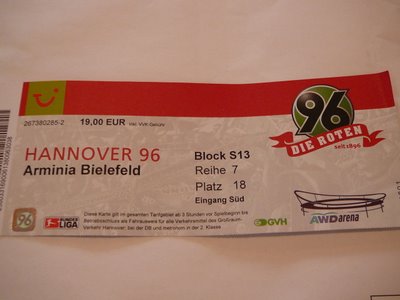
Call me an addict, but I am not yet willing to close the groundhopping books for the year 2006. So, I convinced my buddy J.B. to go for another trip this Saturday, which wasn’t difficult at all. Presenting him with a list of options in Belgium, France, and Germany, he chose Eintracht Frankfurt-Werder Bremen. However, as the website said that there were only some 1000 seats left in the away stand, we decided to play it safe and go to Hannover 96 instead. I ordered tickets through their fantastic website, where you can even choose your exact seat: Südtribune, Block S13, Reihe 7, Platz 17 und 18 at 19 euro each (plus 1 euro booking costs).
At 8.30 I leave my house to walk to the station to take the train to Leuven. At 10.00 J.B. meets me there and we start our long journey to Hannover, some 475 km, over the (mainly German) Autobahn. Hannover is the capital of the state Niedersachsen (Lower-Saxony), in the center-north of Germany. Fortunately, the weather is good and the road is not that busy, except for the (various) parts where they are working on the road, and we arrive in Hannover more than an hour before the start of the game. After a sample of snacks, including fresh Erbsensuppe (pea soup), which is a delight in the winter, we pick up our tickets at the Ticket Office, try to enter at the Nordtribune, and end up circling the stadium to get to our stand.
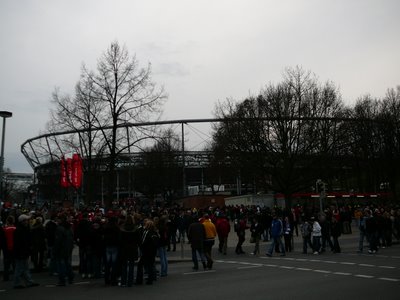
The AWD Stadion is one of the many modern stadiums in Germany. It is the completely refurbished Niedersachsenstadion, originally built in 1954, and was used during the World Cup 2006. It holds 48.933 spectators, although it is seldom sold-out. As most new stadiums today, it holds the name of the main sponsor and is high on comfort, but low on character. Hannover 96 is one of the most commercialized clubs I have ever visited though: food and drink in the stadium could only be paid with a special “Rote Karte” (Red Card), while every single event in the game was sponsored by someone, usually a local furniture shop (corner kicks, last 15 minutes, free kicks, last 5 minutes, etc.). At the same time, non-VIP supporters can only visit the main fan shop after the game! Fortunately I was able to buy a small pennant at a small fan shop at the Südtribune.
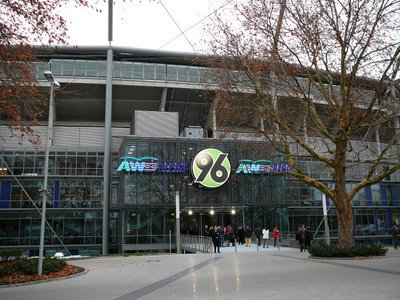
And, now that I am complaining about commercialization anyway, what is up with calling the team “Die Roten”?! Awful! Hannover 96 has traditionally the beautiful color combination of green-black-white (see its beautiful logo!) – hence the friendly relations with Borussia Mönchengladbach (who sport the same colors). However, since a few years Hannover has been playing in red-black and have been merchandizing themselves as “the reds”. I don’t know exactly why, but the fact that major sponsor Tui has red as its main color will not be a coincidence.

Ok, to the game now. We sat behind one of the goal, on the second tier, where we had a fantastic view over the seemingly broad pitch. There is no denying that the stadium is beautiful inside, even if the atmosphere is a bit stale. Not willing to buy into the “red card system”, we did have to watch the game drink- and Wurstless, however, which diminishes the Bundesliga experience (it also felt we were the only ones in the stadium who watched the game Wurstless ;-).
We were sitting almost next to the two blocks occupied by the away fans, but even around us at least one quarter of the fans were from Bielefeld (‘only’ 100 km away; this makes Hannover for them the closets away game; together with Dormund). As always, the atmosphere is a German stadium is friendly and pleasant, with supporters of different teams mingling without any problem. There were some 34.000 supporters for this game between two small teams that do relatively well this season (both hover around position 10 at this moment).
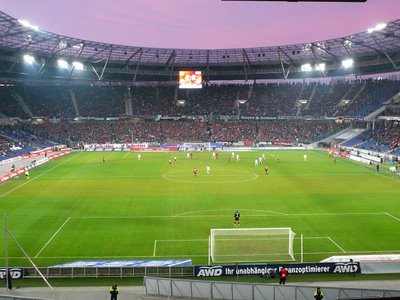
Unfortunately, they didn’t get a good game today. The first half remained 0-0 and there were virtually no good chances for either team. Jiri Snajder, the main player of Hannover, had an off-day, which meant the team had virtually no power up front – the Dutch player Arnold Bruggink, ex-PSV, as always excelled in technically beautiful passes and complete invisibility. At Bielefeld I hardly knew anyone – the Albania Vata didn’t play (he is probably getting too old, but he is crafty little devil) – and the game didn’t change anything.
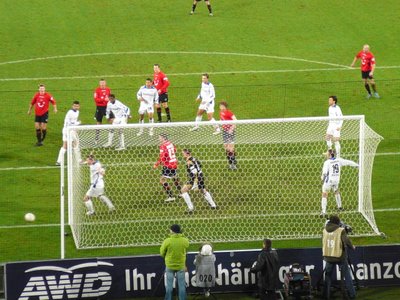
After half time, where we mainly walked around a bit too fight the increasing cold (around 5 degrees Celsius), the game pretty much continued where it had left off. Few chances, few good passes, much fighting against each other and themselves. In the 67th minute, truly out of nowhere, Ndjeng makes the 0-1 for “die Arminen aus Bielefeld”, to the great delight of the blue-red (they haven’t betrayed their colors…. yet?) supporters around us. To be fair, it wasn’t really deserved, although we were already happy to see a goal. Two minutes later, it was already 1-1, by the substituted Brdaric (the only time he wasn’t offside). After that, both teams were so shocked that they actually started to play football. ‘Fortunately’, this only lasted for some ten minutes, after which everything went back to the same old, same old. 1-1 was a deserved final result, and actually two goals better than the level of play indicated (a 0-0 would have fitted the play).

After the game we ran to a stand to buy a Wurst (well, I did, J.B. is a vegetarian-but for the rest a normal guy). On the way back we were led through some villages to the Autobahn, a detour which added further to our already long way back. And, to top it all off, we were drafted in a alocohol check by the Belgian police, which J.B. passed with flying (green-black-white, not red-black!) colors. Around 22.00 he dropped me off in the center of Antwerp. A long day, maybe not too good football, but a Bundesliga game is always worth the trip.







1 comment:
this text is 12 years old so you probably won't read this. But as a "Roter" I have to correct you on this. 96 wearing red jerseys is in fact a big part of the club's tradition. At the beginning of the 20th century the three big clubs of Hannover had green as their main colour. The city council simply decided that HSC (Hannoverscher Sport Club) would play in green jerseys, Arminia Hannover would wear blue ones and that Hannover 96 had to play in red jerseys. Since then they are called "die Roten".
Post a Comment